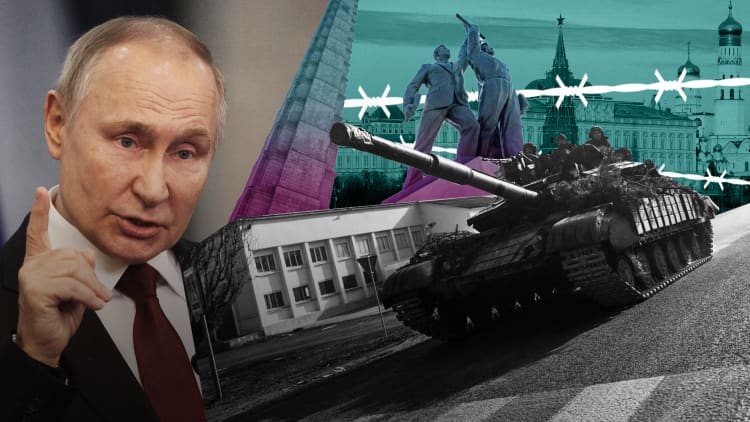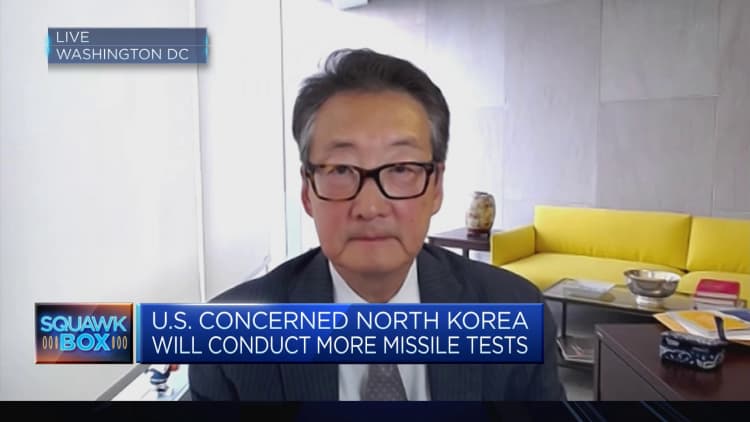
A fire assault drill by North Korean rocket artillery units at an undisclosed location in North Korea in March 2023 in this photo released by North Korea’s Korean Central News Agency (KCNA). Around 6,000 of these units are located in range of South Korean population centers.
KCNA | Reuters
North Korea’s missile launches in the past month have ratcheted up tensions on the Korean Peninsula —but that’s not the only threat the reclusive state poses.
While North Korea’s ballistic missile launches are the ones that grab headlines, the threat of conventional artillery strikes should not be ignored, warned Naoko Aoki, associate political scientist with the Rand Corporation.
North Korea boasts the world’s fourth largest armed forces, according to the Council of Foreign Relations. In late 2022, CFR estimated North Korea had 1.3 million active military personnel, in addition to a 600,000 strong reserve force.
Most military analysts acknowledge that North Korea’s armed forces are no match for the combined U.S. and South Korean forces, but they say that the country can still wreak immense damage on South Korea via conventional arms.
Artillery threat
North Korea has regularly threatened to turn Seoul into a “sea of fire” with its arsenal of weapons, and unlike most of its other threats, this one may not be pure hyperbole.
Asked if such a threat was credible, Victor Cha, senior vice president and Korea Chair at the Center for Strategic and International Studies, replied: “They could do that if they wanted to.”

But he warned that Pyongyang will face a strong response if it ever carried out that threat. “There would be a response [from the U.S. and South Korea] very clearly if they did that. But they could do it if they wanted to.”
A 2020 assessment from policy think tank Rand Corp found that North Korea maintains around 6,000 artillery systems within range of South Korean population centers, including the capital of Seoul which has a population of 10 million.
Rand estimated that if the thousands of artillery systems were deployed and used against civilian targets, they could potentially kill more than 10,000 people in an hour.
“Even brief, narrowly tailored attacks could destroy key industrial facilities and seriously harm the South Korean economy,” the analysts pointed out.
Separately, a 2018 Rand report illustrates that one of the world’s largest semiconductor fabrication plants — Samsung Electronics’ Pyeongtaek plant — is within range of North Korea’s long-range rocket systems, despite being about 100 kilometers from the border.
A 2018 Rand assessment on how far various North Korean artillery systems can reach into South Korea. The longest ranged systems can reach as far as 200 kilometers from the border.
Rand Corporation
Display manufacturer LG Display’s largest OLED manufacturing plant is located in Paju, just nine kilometers from the border and can be reached by the North’s mid-ranged artillery.
“This threat gives North Korea the power to coerce the South Korean government, or to retaliate against South Korean military or political actions, even without resorting to its chemical or nuclear arsenals,” the 2020 report pointed out.
Is it credible?
Rand’s 2020 assessment said it would be difficult for South Korean and U.S. forces to incur significant damage on North Korea’s artillery units, as these will be sheltered from counterfire in underground facilities.
Daniel Pinkston, who lectures on international relations at Troy University in Seoul, said the constant artillery threat may be overlooked by most people, but not by military planners and senior national security officials in Seoul and Washington.
“The missile launches have been high profile because they have been part of testing many new systems that give North Korea greater military capabilities and options,” he told CNBC.

However, Pinkston disagrees with Rand’s report that such a threat can drive South Korea’s government to “do X” — or more specifically, force Seoul into a course of action.
Should North Korea follow through on the threat to attack the South, “the gloves are off” and a response can be expected from South Korean and U.S. forces, he said, highlighting that North Korea will not do well in conventional warfare against the allied forces.
Pinkston pointed out that North Korea is not the only one that can launch an attack at short notice. “Many people don’t seem to realize that a counterattack from the South can be launched on very short notice as well,” he added.
North Korea’s goal, I think, is not simply to prevent an attack from the U.S. and South Korea. It is really to get the United States off the Korean Peninsula.
Victor Cha
Korea Chair, Center for Strategic and International Studies
If the North were to fire on civilian targets, allied forces from the U.S. and South Korea will be able to retaliate quickly by destroying North Korea’s systems.
“If I were the KPA, I’d want to use my munitions for military targets to suppress the counterattack, which would be very intense,” Pinkston added, referring to North Korea’s armed forces, the Korea People’s Army.
Holistic perspective
Why would North Korea need to develop missiles if it holds such a potent threat over South Korea — even if short-lived?
That’s because North Korea’s missile program or its artillery forces cannot be seen in isolation, but need to be considered as part of a bigger threat, explained Cha from CSIS.
The North Korean threat needs to be viewed in its entirety, and the full extent of the danger consists of: The conventional artillery threat over South Korea, its missile and nuclear program, as well as its cyber attack arm, he added.
However, Cha pointed out that there have also been studies that have shown the damage inflicted by North Korean artillery is “not that effective.”

“They may be able to do some damage initially, [but] that damage may be overestimated and that soon after their artillery positions become known, counter battery fire from U.S. and South Korean forces could neutralize that artillery pretty quickly.”
As for North Korea’s missile program, it is designed to be more survivable in order to withstand a preemptive strike from the U.S, as well as to have the capability to strike the U.S., in order to create a so-called “decoupling dynamic” between Washington and Seoul.
The ultimate objective of North Korea, Cha said, is to divide the U.S.-South Korea alliance by creating a homeland security threat, and long range artillery alone is not going to achieve that.
Cha concluded: “North Korea’s goal, I think, is not simply to prevent an attack from the U.S. and South Korea. It is really to get the United States off the Korean Peninsula, and then have a have a nuclear advantage over South Korea. That is ultimately their goal.”